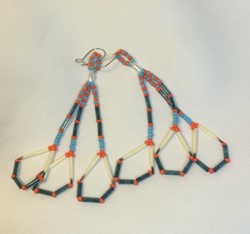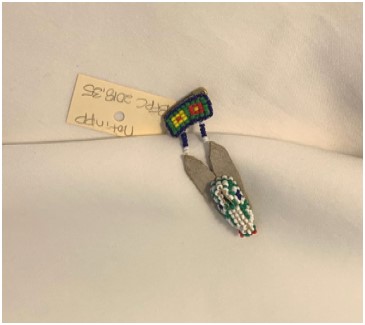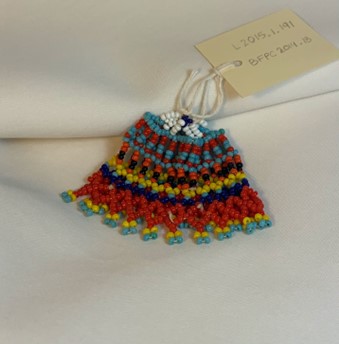
Lakota(?) cultures of the Great Plains
20th century
Glass beads and surgical steel, cotton thread,
L. 1 cm x W. 2 mm x H. 2.5 cm
BFPC collection #2018.34
These colorful earrings are made with light green, dark green, blue, and red seed beads. The almond shape of the transparent green beaded loops suggests that they may represent leaves, or more likely, feathers that are tied along a string. Feathers were commonly worn as status symbols among Great Plains cultures, as they were presented as symbols of recognition for different achievements. Researched by Alexa Langelier

Lakota(?) cultures of the Great Plains
20th century
Glass beads, cloth, and leather, cotton thread,
L. 1.5 cm W. 2 mm x H. 1.5 cm
BFPC collection #2014.16b
Rosettes are circular, beaded, medallion-like objects that serve as decoration on Great Plains cultures traditional clothing, headwear, and carrying bags. The spread-winged bird motif on this medallion is known as the Thunderbird, an avian spirit that is believed to protect humans from evil spirits. In many Great Plains cultures, the color blue symbolizes the sky, while the color yellow represents the East and the direction of the sun. According to some sources, orange may represent the powerful bird, and black represents victories in battle. Researched by Alexa Langelier

Lakota(?) cultures of the Great Plains
20th century
Glass beads, porcupine quills, surgical steel, and cotton thread,
L. 3.8 cm x W. 2 mm x H. 8.9 cm
BFPC collection #2020.18
Women of the Great Plains cultures fostered the development of skilled quillwork, where porcupine quills were gathered, softened, and sometimes dyed with vegetable pigments, and then used to create embroidered, quilled decorations on leather. Women developed elaborate geometric patterns and floral designs, and later men adopted quillwork to make figural designs. When colorful glass seed beads were imported into North America, quill workers quickly embraced them and incorporated them into designs with quillwork, as in these beaded and quilled earrings. Researched by Alexa Langelier

Lakota(?) cultures of the Great Plains
20th century
Glass beads, leather, stainless steel pin, and cotton thread,
L. 1.3 cm x W. 4 mm x H. 1.3 cm
BFPC collection #2018.35
This small beaded pin represents a child in a cradleboard, which is a type of baby carrier that was used by Native cultures of the Great Plains to carry a swaddled child on one’s back like a backpack. Baby carriers were sometimes decorated with elaborate beadwork and gifted to new mothers; this generosity was often returned in the form of elaborately beaded items that the mother would create as gifts for neighbor or family members to celebrate other important life events. Researched by Alexa Langelier

Tarahumara culture
20th century
Glass beads and cotton thread, L. 8.3 cm x W. 2 mm x H. 5 cm
BFPC collection #2014.18
This miniature item of colorful, netted beadwork likely represents a woman’s traditional beaded collar from the Tarahumara cultures, and it was possibly meant to serve as an adornment for a doll. The Tarahumara reside in what is today northern Mexico, but they are culturally a part of the American Southwest cultural group. As with other cultures of the American Southwest, today the Tarahumara produce traditional art to sell in the tourist trade, and this serves as a vital source of income. Researched by Alexa Langelier
For more information, you may contact the researcher(s) noted in the title of this exhibit entry, or Dr. Billie Follensbee, the professor of the course, at BillieFollensbee@MissouriState.edu
